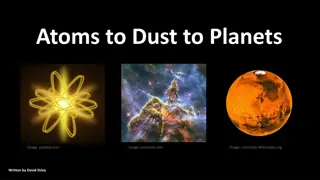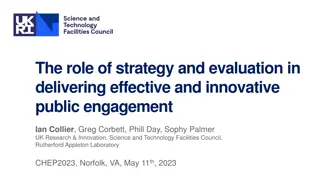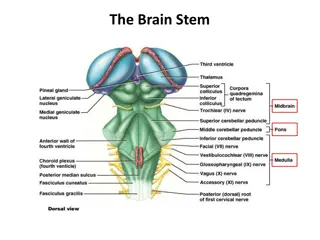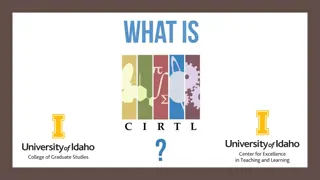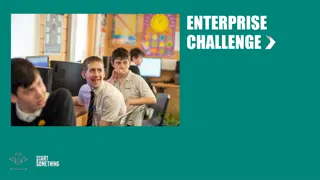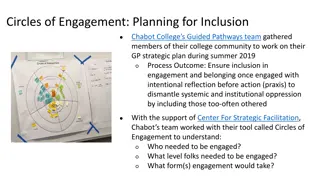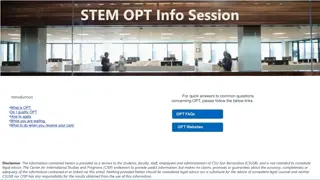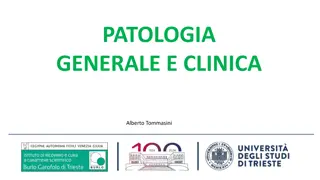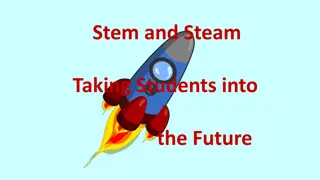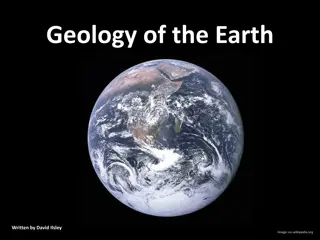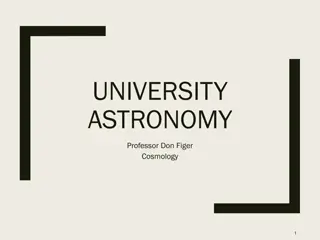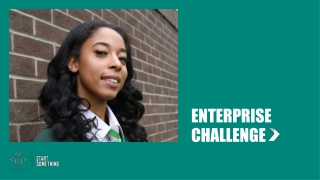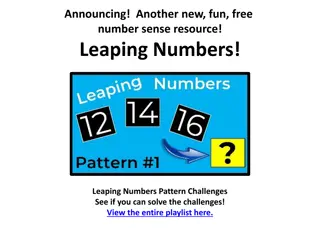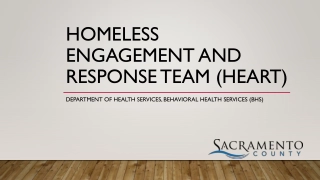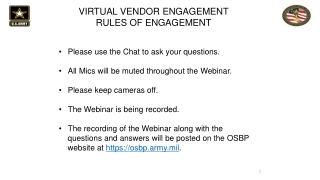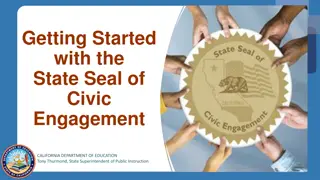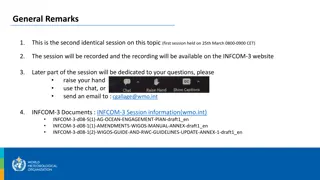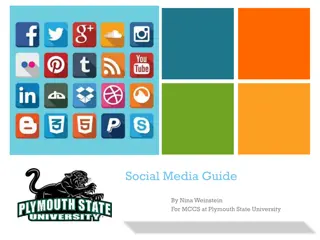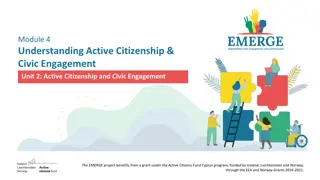Explore The Big Bang Challenge for STEM Engagement
The Big Bang Challenge provides students with exciting problems to solve in science, technology, engineering, and math (STEM). Through design thinking, participants develop important skills like communication and problem-solving while exploring various STEM areas. Choose from seven challenges, such as creating a solution for a healthier planet or transforming sports with technology. Dive into the design process, define your problem statement, and unleash your creativity to find innovative solutions that make a real impact in the world of STEM.
Download Presentation
Please find below an Image/Link to download the presentation.
The content on the website is provided AS IS for your information and personal use only. It may not be sold, licensed, or shared on other websites without obtaining consent from the author. Download presentation by click this link. If you encounter any issues during the download, it is possible that the publisher has removed the file from their server.
Presentation Transcript
THE BIG BANG CHALLENGE TEACHER RESOURCE 1 THE BIG BANG CHALLENGE www.thebigbang.org.uk
What is The Big Bang Challenge? The Big Bang Challenge gives you a problem to investigate and asks you to create a solution to it. It is your chance to: Think like a person working in science, technology, engineering or maths (STEM) , through the design thinking process Get creative Develop important skills such as communication and problem solving Discover more on important areas in STEM Celebrate and share your work 9 THE BIG BANG CHALLENGE www.thebigbang.org.uk
Taking part in The Big Bang Challenge You just need to be curious, willing to try and happy to take on a challenge. There are seven challenges for you to choose from: 1. Can we eat our way to a healthier planet? (slides 11 -23) 2. Technology making a greener world (slides 24 36) 3. Game, set, match: transforming sport with STEM (slides 37 49) 4. How can Robots and AI help humankind? (slides 50 62) 5. Engineering for the extreme (slides 63 75) 6. Can we make our air fresh again? (slides 76 88) 7. On track to net zero? (slides 89 101) Look through the briefs to begin your challenge and start thinking about your solutions! 10 THE BIG BANG CHALLENGE www.thebigbang.org.uk
CHALLENGE 1 CAN WE EAT OUR WAY TO A HEALTHIER PLANET? People in STEM work in a linked-up way, and consider the impact one thing has on another. To succeed on this challenge you will have to think about how things connect, reach detailed conclusions and be creative. 11 THE BIG BANG CHALLENGE www.thebigbang.org.uk
Design thinking To solve this problem you will use a design thinking process. This is what people working in STEM, and more widely, use to create effective solutions. It includes the following steps: 12 THE BIG BANG CHALLENGE www.thebigbang.org.uk
CAN WE EAT OUR WAY TO A HEALTHIER PLANET? Project concept: define your problem It is important to be clear on what problem your solution will solve and spend time on this. Why? The outcome is to create a problem statement. - You will have three steps to follow to create this. - Through creating this you will develop the following skills that STEM jobs value : - Investigative thinking skills - Critical analysis skills - Communication of ideas 13 THE BIG BANG CHALLENGE www.thebigbang.org.uk
CAN WE EAT OUR WAY TO A HEALTHIER PLANET? Project concept define your problem Step 1: Decide on the problem you will solve. How does food link to a sustainable and healthy planet? What problems can you see here? Do any of these link to how you get food, eat it and throw it away? Which problem will you tackle? 14 THE BIG BANG CHALLENGE www.thebigbang.org.uk
CAN WE EAT OUR WAY TO A HEALTHIER PLANET? Project concept define your problem Step 2: Focus your Problem Why is this important? What is the core problem at the heart of the issue? What are the particular issues? Where does it happen? Who does it impact? 15 THE BIG BANG CHALLENGE www.thebigbang.org.uk
CAN WE EAT OUR WAY TO A HEALTHIER PLANET? Project concept define your problem Step 3: Create your Problem Statement, which describes the problem you will solve. The planet has too much greenhouse gases in the atmosphere. My solution will look at greener ways for farms to transport food across the world, to stop greenhouse gases increasing in the atmosphere and help cool the earth. Use the following three W s to create it: WHO or WHAT is facing your problem? WHAT is the problem they are facing? WHY should this problem be solved / WHAT will your solution do and help? 16 THE BIG BANG CHALLENGE www.thebigbang.org.uk
CAN WE EAT OUR WAY TO A HEALTHIER PLANET? Project process ideas, prototype, test The next step is to think of ideas for your potential solutions, decide on your favourite, prototype this idea, and then think of ways to test it against your problem statement. The outcome is to create a solution to your problem and think of ways to test it. - Through doing this you will develop the following skills: - Research and communication skills - Creative and logical thinking - Decision Making 17 THE BIG BANG CHALLENGE www.thebigbang.org.uk
CAN WE EAT OUR WAY TO A HEALTHIER PLANET? Project process ideas. Think of an interesting, and creative solution to your problem. Step 1: Research what is out there already. This will also give you inspiration for your solution. Step 2: Think of at least five new ideas for your solution. Top tips for developing ideas to your solution: - It s not about perfection don t be judgemental. - Warm up your brain before then give yourself a time limit. - Write each new idea on a separate post-it to see them all. - Your idea doesn t have to be 100% original, many ideas adapt, add to an existing idea, or merge two current ideas to create something new. Step 3: Select your top idea , to take forward to the next stage. Use your problem statement to help. 18 THE BIG BANG CHALLENGE www.thebigbang.org.uk
CAN WE EAT OUR WAY TO A HEALTHIER PLANET? Project process prototype Prototype Your Chosen Idea. A prototype is a first drawing or model of an idea. Either draw (2D) or model (3D) your idea. Add labels, or communicate what each part will do, and consider materials, construction, size etc. 19 THE BIG BANG CHALLENGE www.thebigbang.org.uk
CAN WE EAT OUR WAY TO A HEALTHIER PLANET? Project process test How would you test your solution? An important STEM skill is learning from failure. Why is testing important? What can it teach us? Consider how you would test your idea and record this. Would it be tested over time, in different locations, against a control? Would you need to collect data or feedback? 20 THE BIG BANG CHALLENGE www.thebigbang.org.uk
CAN WE EAT OUR WAY TO A HEALTHIER PLANET? Project Outcome reflection Well Done! You have completed your project and use the Design Thinking process. The final stage is to reflect on this, to identify your strengths, what you enjoy and how it can link to a future in STEM. The outcome is to reflect on the project for yourself, your learning and the next steps to take. - Through doing this you will develop the following skills: - Goal-Setting - Resilience - Self-Awareness 21 THE BIG BANG CHALLENGE www.thebigbang.org.uk
CAN WE EAT OUR WAY TO A HEALTHIER PLANET? Project Outcome: reflection. Personal reflection: What were the challenges you faced? How did you overcome difficulty? What parts did you enjoy the most and why? Project reflection:What worked well on this project? Where would you take it next aworking prototype, doing some testing, presenting it? Would you like to try a differentchallenge? Learning reflection: What skills did you develop? What new knowledge did you gain? Have your perceptions about STEM changed, and if so how? What would you do the same and differently in another project? 22 THE BIG BANG CHALLENGE www.thebigbang.org.uk
CAN WE EAT OUR WAY TO A HEALTHIER PLANET? Congratulations on Completing your Project! Through your Project you used the Design Thinking process, which is a highly valued approach in problem solving. You developed and practiced many skills, including - research, creative thinking, communication, logical thinking, decision making, time management and goal setting. These are all essential skills in STEM careers, and through doing this project you have shown you would be really successful in a STEM job. Examples of jobs in this field are: 1. Design Engineer to create new systems for farming. 2. Manufacturing and Mechanical Engineerto create efficient ways to produce chocolate. If you want to celebrate your project further you can enter itinto the BigBang Project Gallery, or Big Bang Competition. 23 THE BIG BANG CHALLENGE www.thebigbang.org.uk
CHALLENGE 2 TECHNOLOGY MAKING A GREENER WORLD People in STEM use new and emerging technologies to help solve problems. To succeed on this challenge you are going to have think ahead, predict and be imaginative. 24 THE BIG BANG CHALLENGE www.thebigbang.org.uk
Design thinking To solve this problem you will use a design thinking process. This is what people working in STEM, and more widely, use to create effective solutions. It includes the following steps: 25 THE BIG BANG CHALLENGE www.thebigbang.org.uk
TECHNOLOGY MAKING A GREENER WORLD Project concept: define your problem It is important to be clear on what problem your solution will solve and spend time on this. Why? The outcome is to create a problem statement. - You will have three steps to follow to create this. - Through creating this you will develop the following skills that STEM jobs value : - Investigative thinking skills - Critical analysis skills - Communication of ideas 26 THE BIG BANG CHALLENGE www.thebigbang.org.uk
TECHNOLOGY MAKING A GREENER WORLD Project concept define your problem Step 1:Decide on the problem you willsolve. What are they key problems in making a sustainableand greener world that you know? What problems can you see here? Which problem will you tackle? 27 THE BIG BANG CHALLENGE www.thebigbang.org.uk
TECHNOLOGY MAKING A GREENER WORLD Project concept define your problem Step 2: Focus your Problem Why is this important? What is the core problem at the heart of the issue? What are the particular issues? Where does it happen? Who does it impact? 28 THE BIG BANG CHALLENGE www.thebigbang.org.uk
TECHNOLOGY MAKING A GREENER WORLD Project concept define your problem Step 3: Create your Problem Statement, which describes the problem you will solve. Use the following three W s to create it: The ocean has too much plastic in it. My solution will use technology to create a way to remove current plastic and stop anymore from entering the ocean, to help the ocean be cleaner. WHO or WHAT is facing your problem? WHAT is the problem they are facing? WHY should this problem be solved / WHAT will your solution do and help? 29 THE BIG BANG CHALLENGE www.thebigbang.org.uk
TECHNOLOGY MAKING A GREENER WORLD Project process ideas, prototype, test The next step is to think ofideas for your potential solutions, decide on yourfavourite, prototype this idea, and then think of ways to test it against your problem statement. The outcome is tocreate a solution to your problem and think of ways to test it. Through doing this you will develop the following skills: Research and communication skills Creative and logical thinking Decision Making 30 THE BIG BANG CHALLENGE www.thebigbang.org.uk
TECHNOLOGY MAKING A GREENER WORLD Project process ideas. Think of an interesting, and creative solution to your problem. Step 1: Research what is out there already. This will also give you inspiration for your solution. Step 2: Think of at least five new ideas for your solution. Top tips for developing ideas to your solution: - It s not about perfection don t be judgemental. - Warm up your brain before then give yourself a time limit. - Write each new idea on a separate post-it to see them all. - Your idea doesn t have to be 100% original, many ideas adapt, add to an existing idea, or merge two current ideas to create something new. Step 3: Select your top idea , to take forward to the next stage. Use your problem statement to help. 31 THE BIG BANG CHALLENGE www.thebigbang.org.uk
TECHNOLOGY MAKING A GREENER WORLD Project process prototype Prototype Your Chosen Idea. A prototype is a first drawing or model of an idea. Either draw (2D) or model (3D) your idea. Add labels, or communicate what each part will do, and consider materials, construction, size etc. 32 THE BIG BANG CHALLENGE www.thebigbang.org.uk
TECHNOLOGY MAKING A GREENER WORLD Project process test How would you test your solution? An important STEM skill is learning from failure. Why is testing important? What can it teach us? Consider how you would test your idea and record this. Would it be tested over time, in different locations, against a control? Would you need to collect data or feedback? 33 THE BIG BANG CHALLENGE www.thebigbang.org.uk
TECHNOLOGY MAKING A GREENER WORLD Project Outcome reflection Well Done! You have completed your project and use the Design Thinking process. The final stage is to reflect on this, to identify your strengths, what you enjoy and how it can link to a future in STEM. The outcome is to reflect on the project for yourself, your learning and the next steps to take. - Through doing this you will develop the following skills: - Goal-Setting - Resilience - Self-Awareness 34 THE BIG BANG CHALLENGE www.thebigbang.org.uk
TECHNOLOGY MAKING A GREENER WORLD Project Outcome: reflection. Personal reflection: What were the challenges you faced? How did you overcome difficulty? What parts did you enjoy the most and why? Project reflection:What worked well on this project? Where would you take it next aworking prototype, doing some testing, presenting it? Would you like to try a differentchallenge? Learning reflection: What skills did you develop? What new knowledge did you gain? Have your perceptions about STEM changed, and if so how? What would you do the same and differently in another project? 35 THE BIG BANG CHALLENGE www.thebigbang.org.uk
TECHNOLOGY MAKING A GREENER WORLD Congratulations on Completing your Project! Through your Project you used the Design Thinking process, which is a highly valued approach in problem solving. You developed and practiced many skills, including - research, creative thinking, communication, logical thinking, decision making, time management and goal setting. These are all essential skills in STEM careers, and through doing this project you have shown you would be really successful in a STEM job. Examples of jobs in this field are: 1. Energy Consultant to create renewable energy systems around the world. 2. Apprentice Engineerto use technology to farm more sustainably. If you want to celebrate your project further you can enter itinto the BigBang Project Gallery, or Big Bang Competition. 36 THE BIG BANG CHALLENGE www.thebigbang.org.uk
CHALLENGE 3 GAME, SET, MATCH: TRANSFORMING SPORT WITH STEM People in STEM work in many different roles, many that we don t expect. To succeed on this challenge, you will have to see STEM in new places and think outside of the box. 37 THE BIG BANG CHALLENGE www.thebigbang.org.uk
Design thinking To solve this problem you will use a design thinking process. This is what people working in STEM, and more widely, use to create effective solutions. It includes the following steps: 38 THE BIG BANG CHALLENGE www.thebigbang.org.uk
GAME, SET, MATCH: TRANSFORMING SPORT WITH STEM Project concept: define your problem It is important to be clear on what problem your solution will solve and spend time on this. Why? The outcome is to create a problem statement. - You will have three steps to follow to create this. - Through creating this you will develop the following skills that STEM jobs value : - Investigative thinking skills - Critical analysis skills - Communication of ideas 39 THE BIG BANG CHALLENGE www.thebigbang.org.uk
GAME, SET, MATCH: TRANSFORMING SPORT WITH STEM Project concept define your problem Step 1: Decide on the problem you will solve. What are key problems in sport that you know? What problems can you see here? Which problem will you tackle? 40 THE BIG BANG CHALLENGE www.thebigbang.org.uk
GAME, SET, MATCH: TRANSFORMING SPORT WITH STEM Project concept define your problem Step 2: Focus your Problem Why is this important? What is the core problem at the heart of the issue? What are the particular issues? Where does it happen? Who does it impact? 41 THE BIG BANG CHALLENGE www.thebigbang.org.uk
GAME, SET, MATCH: TRANSFORMING SPORT WITH STEM Project concept define your problem Step 3: Create your Problem Statement, which describes the problem you will solve. Use the following three W s to create it: Blind people cannot access sport easily. My solution will create better facilities for blind people to take part in group sports, to improve their physical and mental health. WHO or WHAT is facing your problem? WHAT is the problem they are facing? WHY should this problem be solved / WHAT will your solution do and help? 42 THE BIG BANG CHALLENGE www.thebigbang.org.uk
GAME, SET, MATCH: TRANSFORMING SPORT WITH STEM Project process ideas, prototype, test The next step is to think ofideas for your potential solutions, decide on yourfavourite, prototype this idea, and then think of ways to test it against your problem statement. The outcome is tocreate a solution to your problem and think of ways to test it. Through doing this you will develop the following skills: Research and communication skills Creative and logical thinking Decision Making 43 THE BIG BANG CHALLENGE www.thebigbang.org.uk
GAME, SET, MATCH: TRANSFORMING SPORT WITH STEM Project process ideas. Think of an interesting, and creative solution to your problem. Step 1: Research what is out there already. This will also give you inspiration for your solution. Step 2: Think of at least five new ideas for your solution. Top tips for developing ideas to your solution: - It s not about perfection don t be judgemental. - Warm up your brain before then give yourself a time limit. - Write each new idea on a separate post-it to see them all. - Your idea doesn t have to be 100% original, many ideas adapt, add to an existing idea, or merge two current ideas to create something new. Step 3: Select your top idea , to take forward to the next stage. Use your problem statement to help. 44 THE BIG BANG CHALLENGE www.thebigbang.org.uk
GAME, SET, MATCH: TRANSFORMING SPORT WITH STEM Project process prototype Prototype Your Chosen Idea. A prototype is a first drawing or model of an idea. Either draw (2D) or model (3D) your idea. Add labels, or communicate what each part will do, and consider materials, construction, size etc. 45 THE BIG BANG CHALLENGE www.thebigbang.org.uk
GAME, SET, MATCH: TRANSFORMING SPORT WITH STEM Project process test How would you test your solution? An important STEM skill is learning from failure. Why is testing important? What can it teach us? Consider how you would test your idea and record this. Would it be tested over time, in different locations, against a control? Would you need to collect data or feedback? 46 THE BIG BANG CHALLENGE www.thebigbang.org.uk
GAME, SET, MATCH: TRANSFORMING SPORT WITH STEM Project Outcome reflection Well Done! You have completed your project and use the Design Thinking process. The final stage is to reflect on this, to identify your strengths, what you enjoy and how it can link to a future in STEM. The outcome is to reflect on the project for yourself, your learning and the next steps to take. - Through doing this you will develop the following skills: - Goal-Setting - Resilience - Self-Awareness 47 THE BIG BANG CHALLENGE www.thebigbang.org.uk
GAME, SET, MATCH: TRANSFORMING SPORT WITH STEM Project Outcome: reflection. Personal reflection: What were the challenges you faced? How did you overcome difficulty? What parts did you enjoy the most and why? Project reflection:What worked well on this project? Where would you take it next aworking prototype, doing some testing, presenting it? Would you like to try a differentchallenge? Learning reflection: What skills did you develop? What new knowledge did you gain? Have your perceptions about STEM changed, and if so how? What would you do the same and differently in another project? 48 THE BIG BANG CHALLENGE www.thebigbang.org.uk
GAME, SET, MATCH: TRANSFORMING SPORT WITH STEM Congratulations on Completing your Project! Through your Project you used the Design Thinking process, which is a highly valued approach in problem solving. You developed and practiced many skills, including - research, creative thinking, communication, logical thinking, decision making, time management and goal setting. These are all essential skills in STEM careers, and through doing this project you have shown you would be really successful in a STEM job. Examples of jobs in this field are: 1. Test and ValidationEngineer at Nike to develop technology to measure your fitness. 2. Sports Technologistto create the best materials to enhance athletes' performance. If you want to celebrate your project further you can enter itinto the BigBang Project Gallery, or Big Bang Competition. 49 THE BIG BANG CHALLENGE www.thebigbang.org.uk
CHALLENGE 4 HOW CAN ROBOTS AND ARTIFICIAL INTELLIGENCE (AI) HELP HUMANKIND? People in STEM often work with new and emerging technologies, which aren t yet fully understood. To succeed on this challenge you will have to think creatively, use your imagination and consider the ethics and implications of your solution. 50 THE BIG BANG CHALLENGE www.thebigbang.org.uk
Design thinking To solve this problem you will use a design thinking process. This is what people working in STEM, and more widely, use to create effective solutions. It includes the following steps: 51 THE BIG BANG CHALLENGE www.thebigbang.org.uk
HOW CAN ROBOTS AND AI HELP HUMANKIND? Project concept: define your problem It is important to be clear on what problem your solution will solve and spend time on this. Why? The outcome is to create a problem statement. - You will have three steps to follow to create this. - Through creating this you will develop the following skills that STEM jobs value : - Investigative thinking skills - Critical analysis skills - Communication of ideas 52 THE BIG BANG CHALLENGE www.thebigbang.org.uk
HOW CAN ROBOTS AND AI HELP HUMANKIND? Project concept define your problem Step 1: Decide on the problem you will solve. What problems do humans face that could be helped by robots and AI? What problems can you see here? Which problem will you tackle? 53 THE BIG BANG CHALLENGE www.thebigbang.org.uk
HOW CAN ROBOTS AND AI HELP HUMANKIND? Project concept define your problem Step 2: Focus your Problem Why is this important? What is the core problem at the heart of the issue? What are the particular issues? Where does it happen? Who does it impact? 54 THE BIG BANG CHALLENGE www.thebigbang.org.uk
HOW CAN ROBOTS AND AI HELP HUMANKIND? Project concept define your problem Step 3: Create your Problem Statement, which describes the problem you will solve. Some people in the world do not have access to clean water. My solution will use robots and AI to make all water safe to drink, which will decrease illnesses and improve sanitation. Use the following three W s to create it: WHO or WHAT is facing your problem? WHAT is the problem they are facing? WHY should this problem be solved / WHAT will your solution do and help? 55 THE BIG BANG CHALLENGE www.thebigbang.org.uk
HOW CAN ROBOTS AND AI HELP HUMANKIND? Project process ideas, prototype, test The next step is to think ofideas for your potential solutions, decide on yourfavourite, prototype this idea, and then think of ways to test it against your problem statement. The outcome is tocreate a solution to your problem and think of ways to test it. Through doing this you will develop the following skills: Research and communication skills Creative and logical thinking Decision making 56 THE BIG BANG CHALLENGE www.thebigbang.org.uk
HOW CAN ROBOTS AND AI HELP HUMANKIND? Project process ideas. Think of an interesting, and creative solution to your problem. Step 1: Research what is out there already. This will also give you inspiration for your solution. Step 2: Think of at least five new ideas for your solution. Top tips for developing ideas to your solution: - It s not about perfection don t be judgemental. - Warm up your brain before then give yourself a time limit. - Write each new idea on a separate post-it to see them all. - Your idea doesn t have to be 100% original, many ideas adapt, add to an existing idea, or merge two current ideas to create something new. Step 3: Select your top idea , to take forward to the next stage. Use your problem statement to help. 57 THE BIG BANG CHALLENGE www.thebigbang.org.uk






